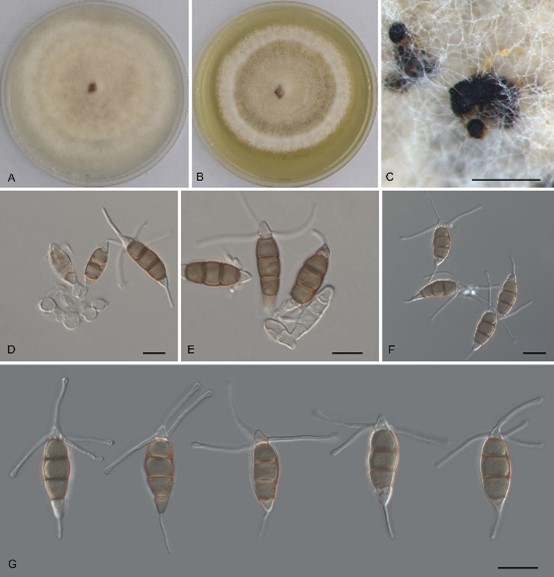Pestalotiopsis castanopsidis N. Jiang, in Jiang, Voglmayr, Xue, Piao & Li, Microbiology Spectrum: 10.1128/spectrum.03272-22, 7 (2022)
Index Fungorum number: IF 841308; MycoBank number: MB 841308; Facesoffungi number: FoF 11690;
Etymology – named after the host genus, Castanopsis.
Pathogenic to host leaves. Asexual state: Conidiomata in culture sporodochial, aggregated or solitary, erumpent, pulvinate, black, 50–350 μm diam., exuding black conidial masses. Conidiophores indistinct, usually reduced to conidiogenous cells. Conidiogenous cells hyaline, smooth, cylindrical to spherical, annelidic, 5–11.5 × 2.5–7 μm, mean ± SD = 7.2 ± 2.5 × 4.4 ± 1.4 μm. Conidia fusoid, straight or slightly curved, 4-septate, smooth, slightly constricted at the septa, (23–)24–27.5(–29) × (7–)8–11(–11.5) μm, mean ± SD = 25.7 ± 1.8 × 9.3 ± 1.4 μm (n = 50), L/W = 2.3–4; basal cell obconic with a truncate base, thin-walled, hyaline or pale brown, 4–5 μm; median cells 3, trapezoid or subcylindrical, concolourous, brown, thick-walled, the first median cell from base (5.5–)6–7 μm long, the second cell (5.5–)6–7.5(–8) μm long, the third cell 5.5–6.5(–7) μm long, together (16–)17–20(–20.5) μm long; apical cell conic with an acute apex, thin-walled, hyaline, (2.5–)3–4.5(–5) μm long; basal appendage single, unbranched, tubular, centric, straight or slightly bent, (8.5–)9.5–14(–15) μm long, mean ± SD = 11.7 ± 2.4 μm; apical appendages 3–4, unbranched, tubular, knobbed, centric, straight or slightly bent, (17–)17.5–23(–24.5) μm long, mean ± SD = 20.3 ± 2.7 μm. Sexual morph unknown.
Culture characters – Colonies on MEA flat, spreading, with flocculent aerial mycelium forming concentric rings and entire edge, off-white to sienna, reaching 60 mm diameter after 10 days at 25°C, forming black conidiomata with black conidial masses; on PDA, flat, spreading, with flocculent aerial mycelium forming concentric rings and undulate edge, pale luteous to fawn, reaching a 70-mm diameter after 10 days at 25°C, forming black conidiomata with black conidial masses.
Material examined – China, Guangdong Province, Qingyuan City, Yangshan County, Guangdong Nanling Nature Reserve, on diseased leaves of Castanopsis lamontii (Fagaceae), 4 December 2019, Shang Sun (holotype CAF 800021 = JNH0017; ex-holotype culture CFCC 54430). ibid., CFCC 54305 and CFCC 54384
Distribution – China
Sequence data – ITS: OK339732 (ITS1/ITS4); tef1: OK358493 (EF1-728F/EF2); tub2: OK358508 (Bt2a/Bt2b)
Notes – Three isolates of Pestalotiopsis castanopsidis from Castanopsis hystrix and C. lamontii clustered into a distinct clade phylogenetically close to P. jesteri (Fig. 1). However, P. castanopsidis differs from P. jesteri by obviously larger conidia (23 to 29 by 7 to 11.5 μm in P. castanopsidis versus 19 to 23 by 5 to 7 μm in P. jesteri) (24). In addition, P. castanopsidis can be distinguished from P. jesteri by sequence data (nucleotide differences: in the ITS, 4/364 [1.1%]; in tub2, 14 or 15/438 [3.2 to 3.42%]).

Fig. 7. Morphology of Pestalotiopsis castanopsidis (CFCC 54430). A. Colony on PDA after 10 d at 25 °C; B. Colony on MEA after 10 d at 25 °C; C. Conidiomata formed on PDA; D, E. conidiogenous cells giving rise to conidia; F, G. conidia. — Scale bars: C = 200 μm; D–G = 10 μm.
